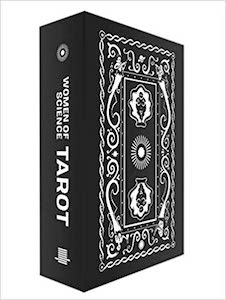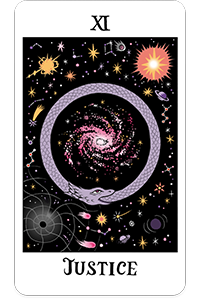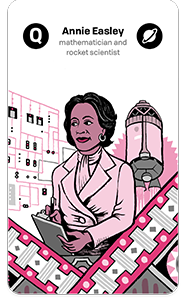
Women of Science Tarot, by Massive Science
MIT Press, 0262539934, 94 pages, September 2020
Did you know the first African American woman to get a PhD in chemistry was Marie Maynard Daly? I didn’t until recently! This is one of the many things I’ve learned from Massive Science’s Women of Science Tarot deck. Though it is promoted as a game deck, it has all the features of a standard tarot deck. Designed to explore the tarot through the lens of science, all the minor arcana features pioneering women who made their mark in scientific fields. The blending of tarot, science, and inspirational women makes this one radically unique and empowering way to seek guidance.
Before diving into the Women of Science Tarot, let’s start with the organization, Massive Science, who published this deck in coordination with MIT Press. Massive Science is a content and media company that has a consortium of scientists publishing articles for the masses. They deliver cutting-edge scientific research to their subscribers, all authored by current scientists in the field. As of now, scientists from over 50 countries have joined Massive Science’s mission of “giving science a voice in cultural conversation.” 1 You can learn more about this innovative organization here.
The community-centered approach of Massive Science is wonderfully applied to the Women of Science Tarot, which features 56 women scientists that have contributed to advancing their respective fields of STEM (science, technology, engineering, and mathematics). These scientists all worked to overcome obstacles in their personal life and careers to leave a lasting legacy. Honestly, I am not familiar with most of the women on the cards. It has been exciting to learn more about the biographical information of these women and the paths they forged.
The box of Women of Science Tarot is well-designed and looks very couth. Upon close inspection, the box dons what appears to be a Venus of Willendorf symbol, along with mer-women holding science tools like beakers and telescopes. My favorite part was the number of players ranging from 1- ∞, once again promoting a sense of inclusivity.

Opening the box reveals a glossy, sleek guidebook and bright pink cards. The guidebook is color-coded by section. The Introduction is brief, but does include an informative suggestion to “Use the meaning of each card to narrate the plot points of a story you tell yourself or a friend.” 2 This is very helpful advice on how to use this deck for guidance, as the meanings aren’t as explicitly stated for each card and require a bit of ingenious thinking to make the connections — a very fitting method for a science-themed deck!
The next section is Major Arcana. The major arcana cards all have science images on them, intended to represent the traditional meaning of the card but through a scientific lens. The description in the guidebook reflects this scientific paradigm and ties in bits of history, knowledge, and insight for reflection. For instance, the description of the Death card discusses the extinction of the dinosaurs with a reminder that sometimes old systems of beliefs need to die off for new ones to emerge. 3
One of my favorite cards in the major arcana of this deck is Justice, which features what appears to be a swirling galaxy surrounded by the ouroboros. This card perfectly captures the merge of esoteric, mystical knowledge with science. The guidebook description discusses the conservation of energy in physics and how new stars and galaxies are constantly being formed from the remnants of old stars. 4 This is beautiful to me and really hits my soul, knowing this process is always in motion. This scientific knowledge seems to bring gnostic wisdom to life by allowing one to see how these principles are embodied in the Universe, nature, and life.
The final section is Minor Arcana, which is divided into colors to distinguish the four suits. This deck labels them nano (cups), micro (wands), macro (pentacles), and astro (swords). Nano represents sciences in the invisible field, such as math and physics; micro is the suit of molecular fields, such as chemistry and microbiology; macro is the systematic fields, such as ecology and geology; astro is the cosmic fields like astronomy. 5
The minor arcana cards have the name of the woman in the top center, with the rank to the left and the suit symbol to the right. Underneath the woman’s name is the type of scientist she was. Then there is an image of her on the card, depicting each woman in her element. All the cards have a color palette of pink, maroon, grey, and black, which makes for visually appealing color contrast on the cards. The women on the cards span centuries, come from different economic backgrounds, and represent a range of cultures, nationalities, and races, which is something I always appreciate! Yet another example of inclusivity in this deck.

To be honest, at first the symbols on the cards were a bit confusing to me. But once I found the explanations of suits in the guidebook the cards made a lot more sense. I would recommend looking at it on page 32, along with the brief description of each type of minor card on page 33, before doing your first reading. Once I understood the correspondences, the cards became much more intuitive. I was then able to translate my readings better because I could draw from the energy of the traditional tarot card and mix it with the message of the Women of Science description of the scientist featured on the cards drawn.
However, even with the informative cards, I still rely heavily on the guidebook for the purpose of familiarizing myself with each scientist. While some are well-established heroes of mine, such as Hypatia (Ace of Astro) and Ursula K. LeGuin (Page of Astro), the majority of women I have yet to learn about. For me, this is a fun endeavour because I find out more about each woman’s inspirational story, while also buffing up on my scientific knowledge.
It’s an interesting combination to be in the midst of an intuitive reading, when suddenly I find myself researching more about mRNA to better understand the message Elisa Izaurraide (Two of Micro) has for my life. Since she’s appeared in my readings three times so far, I feel there’s a deeper connection here I need to make with her, and to do this requires me to delve into her research and more deeply ponder how it may be relevant to my own life.
I’ve always loved reading biographies of women because their life stories are often filled with nuggets of wisdom and motivation. In the highlight reel society of our time, featuring on the most memorable Instagram posts to paint a picture of perfection, biographies have always reminded me of the highs and lows of life that no one can hide from. They feed me stories of how women before me have overcome their challenges, conquered their insecurities, and pushed forward on their path, regardless of the obstacles that stand in their way — and not without the occasional fall from grace or grief-striking moments in life that seem to rip it apart at the seams, humbling me to my own perceived slights from the Universe.
Women of Science Tarot is the perfect mixture of stories about these scientists’ lives and guidance for our own lives, distilled from their accomplishments, struggles, and research. Using this deck may be a new style for more intuitive readers, but the descriptions in the guidebook make it easily accessible to even the left-brained, more creative thinkers to find meaning from the lives of these scientists. It’s a different type of reading that prompts us to celebrate the pioneering path of women scientists, while also promoting creativity in how we invite their stories into our lives to bring us to new heights and revelation. I highly recommend it to everyone, for we can all use a bit of scientific wisdom and women empowerment in our lives.
Alanna Kali is an astrologer, numerologist, and pioneer spirit that loves to explore life through the lens of depth psychology. She has a passion for studying the humanities and social trends. Her academic work is centered upon reuniting body, mind, and spirit through eco-psychology. She loves reading, spending time in nature, and travel.
References
- (https://massivesci.com/about/)
- p. 5
- p. 22
- p. 20
- p. 32
